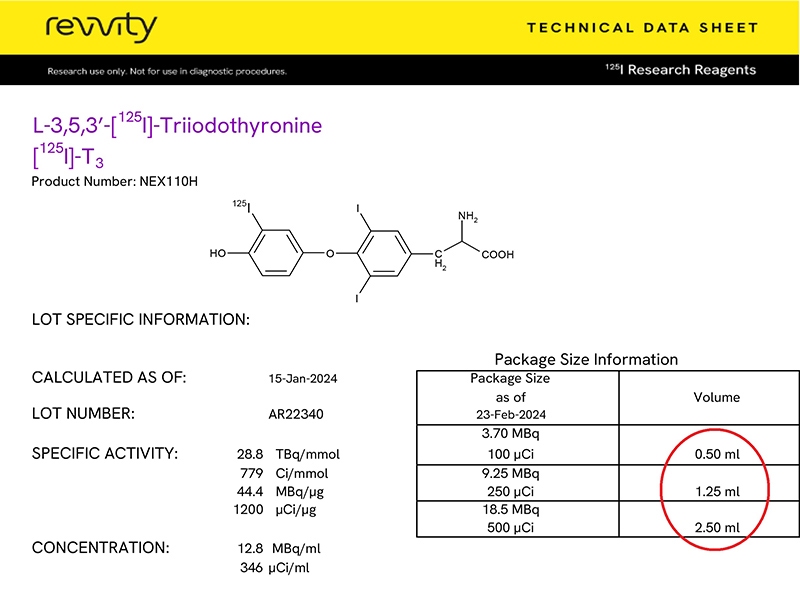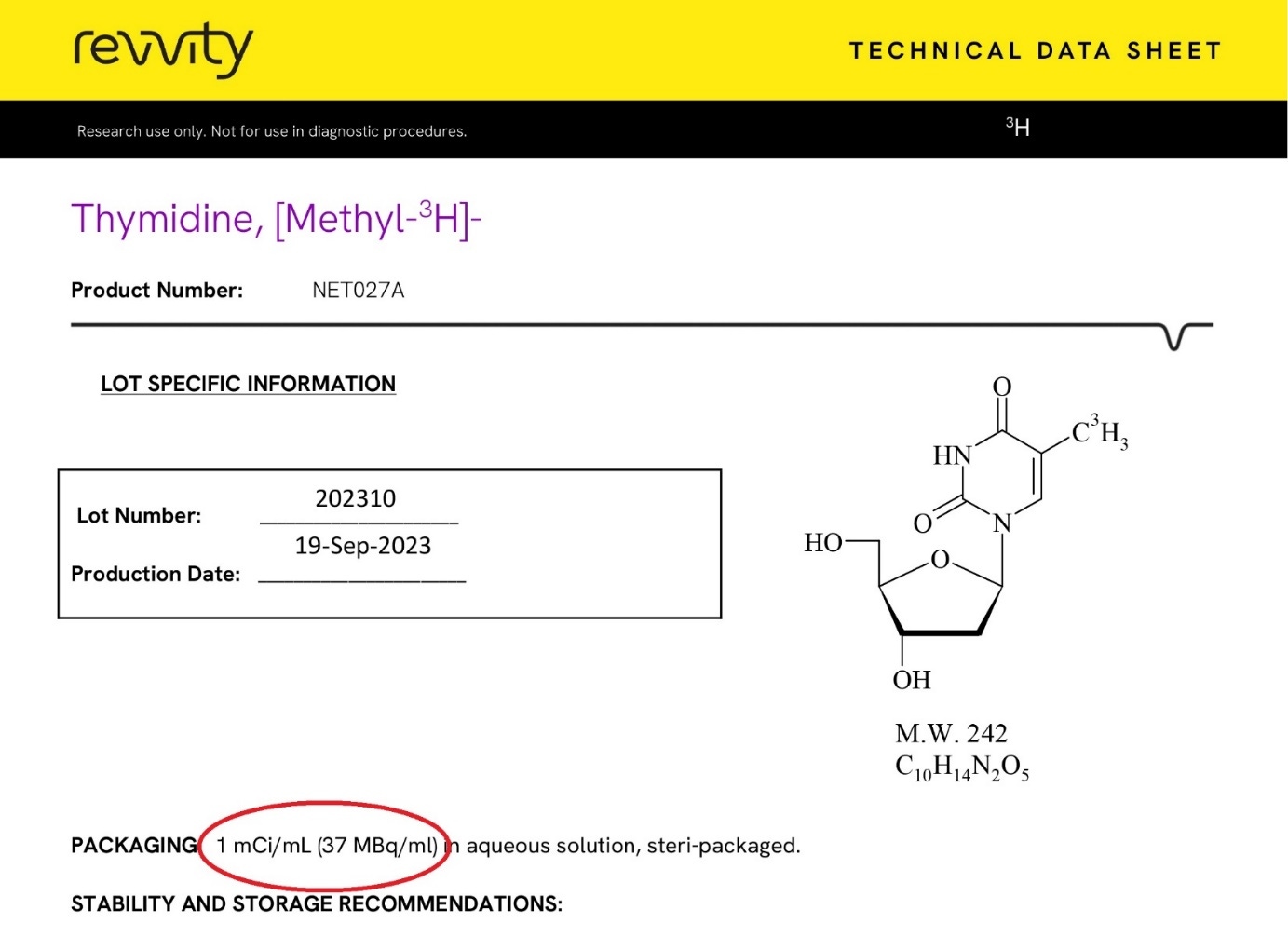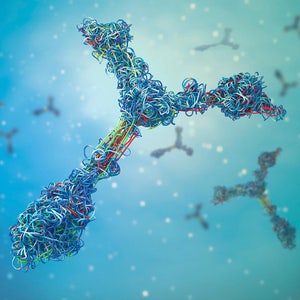
Definitions
General
- Radioactive decay - the process by which an unstable isotope emits energy to reach a more stable state (Entropy). Radioactive material decays until only stable substance is left and the decay of a substance is fixed and measurable.
- Half-life - the time it takes for a product to decay sufficiently to convert half of its mass to a stable form. The half-life of an isotope is fixed.
Units of radioactivity
- Curie or Ci - the most common unit of measure for the radioactivity of a substance. 1 Ci = 3.7×1010 disintegrations per second = 2.22×1012 disintegrations per minute (dpm). The term is most often used as a microCurie (µCi).
- 1 µCi = 3.7×104 disintegrations per second = 2.22×106 disintegrations per minute (dpm).
- Bequerel or Bq - IUPAC unit of measure for radioactivity of a substance. 1 Bq = the quantity of material in which one nucleus decays per second.
- dpm - the abbreviation for disintegrations per minute. This unit is directly related to the counts that one detects in a radiometric detection instrument.
Unit conversions
To convert from Bq to Ci and vice versa:
- 1 Bq = 2.7X10-11 Ci = 1 dps = 60 dpm
- 1 Ci = 3.7X1010 Bq = 3.7X1010 dps = 2.22X1012 dpm
| To convert from __ to __: | Multiply by: |
|---|---|
| from Ci to Bq | 3.7X1010 |
| from Bq to Ci | 2.7X10-11 |
| from Ci to dpm | 2.22X1012 |
| from mCi to dpm | 2.22X109 |
| from dpm to Ci | 4.50x10-13 |
| from dpm to mCi | 4.50x10-10 |
| from Bq to dpm | 60 |
| from TBq to dpm | 6.0X1013 |
| from dpm to Bq | 1.67x10-2 |
| from dpm to TBq | 1.67x10-14 |
Notes:
1 mCi (milliCurie) = 10-3 Ci
1 TBq (TeraBequerel) = 1012 Bq
Specific activity
The specific activity is one of the key factors used to determine which product to use for your detection method and to obtain optimal assay performance.
- Specific activity (SA) - the amount of radiolabeled mass in a sample, often expressed as Ci/mmol or Ci/mg.
- Theoretical maximum specific activity - Each radioisotope has a maximum theoretical specific activity, often measured in Ci/mmol of the radioactive atom. This is the specific activity if 100% of the molecules contain one isotopic label. For example, the theoretical maximum specific activity for 33P is ~5000 Ci/mmol. The closer the specific activity of 33P-gamma-ATP (which has only one possible labeling position) is to the theoretical maximum specific activity for 33P, the greater the proportion of nucleotide molecules that are labeled with the radioisotope.
Concentration
Concentration refers to the amount of material (solute) dissolved in a given volume of liquid (solvent). There are two ways of expressing concentration when dealing with radioactivity.
- Radioactive concentration, also known as radiochemical concentration (mCi/mL or µCi/mL) - the total amount of radioactivity per unit volume
- Molar concentration (µM) - the total concentration (in moles) of both the labeled and unlabeled product per unit volume
The radioactive and molar concentration may dictate which formulation you need to purchase. The radiochemical concentration and the molar concentration have a direct linear relationship.
Dates
- Fresh lot date - one of the scheduled dates of manufacture for a radiochemical. See the fresh lot date schedule on our product pages to find the schedule for your product of interest. The radioactive concentration will be highest on the fresh lot date.
- Stock date (sometimes referred to as Lot date) - the date on which the lot of the radionuclide was manufactured and put into stock
- Ship date - the date on which a particular product was shipped to you. For many radionuclides, this is also the date on which the product was dispensed. In such cases, the actual dispensed volume is adjusted so that the vial will contain the specified amount of radioactivity on the calibration date.
- Calibration date - date on which the radioactive concentration of the material is exactly the concentration described on the technical data sheet. This date is not the same as the fresh lot date but is normally several days away from the fresh lot day. This means that if a product is shipped before the calibration date, it will arrive with a higher radioactive concentration than that described on the technical data sheet. If the product is shipped after the calibration date, the radioactive concentration will be lower.
Specific activity and radioactive concentration on the date of use
- Obtain the catalog number and lot number from the product packaging.
- Download the Certificate of Analysis from our product pages to obtain the calibration date, specific activity, and radioactive concentration. Make sure to get the Certificate of Analysis (COA) from your lot of interest. See the example below.
- For 32P and 35S isotopes, use the Radiochemical Calculation Tool for 32P and 35S to determine the specific activity and radioactive concentration for your date of use.
For other isotopes, use the General Radiochemical Calculations Tool.
On some COAs we also print a method to calculate the activity yourself.
Adjusting the specific activity
For some applications you will need to add cold (unlabeled) material to bring the molar concentration up to the needed level. An example might be a kinase enzyme reaction in which the ATP concentration must be 50 µM, but the radiolabeled ATP is 1.7 µM.
Volume calculations for radiolabeled compounds
If the certificate of analysis (COA) for your product looks like this example, the dispensed volume is shown on the COA.

Example CoA
If the certificate of analysis (COA) for your product looks like this example, the dispensed volume can be calculated from the total amount of radioactivity in the vial and the radioactive concentration shown on the COA.

Total radioactivity (mCi)= Volume (mL)
Concentration (mCi/mL)
Volume calculations for radionuclides
For many radionuclide products, no volumes are stated on the certificate of analysis (COA) because these products are dispensed to order. The volume dispensed will depend on the amount you ordered and on the radioactive concentration that the product will have on the calibration date. The Certificate of Analysis (COA) for such products will contain the statement "Values given are all as of Stock Date. Calibration Date is x days from Ship date."
- Obtain the Ship date from your shipping documents. This is also the date on which your product was dispensed.
- Obtain the Stock date, the Concentration, and Calibration date from the Certificate of Analysis (available online foreach product). The Calibration date will be given as a number of days past the Ship date.
Example:
Stock date = 9 Aug 2010
Concentration on the Stock date = 196.68 mCi/mL
Ship date = 24 Aug 2010
Calibration date = 31 Aug 2010 (7 days after Ship date)
Total days between Stock date and Calibration date = 15 + 7 = 22 days
-
Calculate the radioactive concentration on the calibration date (factoring in decay).
Example: 0.4417 (Decay factor for 86Rb, for 22 days) x 196.68 mCi/mL (conc on the Stock date) = 86.87 mCi/mL (conc on the Calibration date)
Decay table on CoA
- To calculate the volume supplied in your vial, divide the amount of radioactivity you ordered by the radioactive concentration on the Calibration date.
If we ordered 5 mCi, we would receive (5 mCi/86.87 mCi/mL) = 0.058 mL = 58 µL.
Molarity of material (labeled and unlabeled combined)
- Obtain the Concentration and Specific activity from the Certificate of Analysis (COA)
- a) If the Specific activity is expressed as Ci/mmol, divide the concentration by the Specific activity as in the example below.
In this example (3H-thymidine, NET027Z lot 201008):
Concentration = 1.0 mCi/mL = 1.0 Ci/L
Specific activity = 83.2 Ci/mmol
We find the molarity to be:
(1.0 Ci/L)/(83.2 Ci/mmol) = 0.012 mmol/L = 12 µM
b) If the Specific activity is expressed as mCi/mg, obtain the Molecular weight of the material and use the formula below. The Molecular weight is usually shown under the chemical structure diagram on the COA. For radionuclide products, the specific activity is given per mass of radionuclide itself, rather than the full salt.
In this case we use the formula below:
__Concentration (mCi/mL) = Molarity (mmol/mL)
SA (mCi/mg) x MW (mg/mmol)
Molarity of a carrier-free radionuclide
For a radionuclide product that is carrier-free, each atom changes to a different substance as it decays. As a result, both the Radioactive concentration and the Molar concentration decrease over time, but the Specific activity remains constant.
- Obtain the Concentration and Specific activity from the Certificate of Analysis (COA)
- Obtain the Molecular weight of the radionuclide (without including any counterions).
In this example (125Iodine):
Specific activity = 17.4 Ci/mg
Molecular weight of Iodine-125 = 125 mg/mmol - We first calculate the specific activity in terms of moles (Ci/mmol):
(17.4 Ci/mg) x (125 mg/mmol) = 2175 Ci/mmol
For this carrier-free radionuclide, this value remains constant over time. - We now calculate the Concentration on the date you will use the product. (This calculation is described above in Volume calculations for radionuclides).
In this example, we will use a value of 86.87 mCi/mL (= 86.87 Ci/L) for Concentration on the date of use. - We divide the Concentration by the Ci/mmol, and we find the molarity to be:
(86.87 Ci/L)/ (2175 Ci/mmol) = 0.0399 mmol/L = 39.9 µM
Percent radioactive material
Example: What percentage of S-adenosyl methionine, NET155H lot 615548, is actually labeled?
The simple answer is to divide the actual specific activity by the theoretical maximum specific activity for the radiochemical, taking into account the number of possible labeling positions. For this product, there are three possible labeling positions. The maximum theoretical specific activity per tritium is ~29 Ci/mmol. So, for this lot, the percentage of molecules labeled on three positions would be 78/87 = 89.7%. In reality, you need to look at the mass spectrometry analysis of this lot to see the ratio of S-adenosyl methionine with 0, 1, 2 and 3 tritiums. The specific activity is the weighted average of all 4 species. For this particular lot the ratios are 8.1%, 0.7%, 2.2% and 89.0%, respectively. In this case, the two results are close.
Another way to view this is to say that on average, there are (78/29 =) 2.69 tritiums per molecule of S-adenosyl methionine in this lot. Again, looking at the mass spectrometry analysis would give you a more-realistic profile of the product.
| Radioisotope | Theoretical maximum specific activity (per label) |
|---|---|
| 32P | 9120 Ci/mmol |
| 35S | 1488 Ci/mmol |
| 3H | 29 Ci/mmol |
| 125I | 2200 Ci/mmol |
| 14C | 62 mCi/mmol |
Converting dpm to moles
- Obtain the Specific activity from the Certificate of Analysis (COA). Remember to factor in decay if applicable.
-
Convert your measured dpm to Curies
1 Curies (Ci) = 2.22 x 1012 dpm
Example: 100,000 dpm/(2.22 x 1012 dpm/Ci)= 4.5 x 10-8 Ci
- Convert from Curies to moles, using the specific activity.
In this example (3H-thymidine):
Specific activity = 83.2 Ci/mmol
4.5 x 10-8 Ci x (1 mmol/83.2 Ci) = 5.4 x 10-10 mmol = 0.54 pmoles
Note: You will need to factor in any molar dilution you made with "cold" (unlabeled) compound - in this case, unlabeled thymidine. This is because diluting with unlabeled material will change the specific activity. In this case, specific activity is given in units of Curies per millimole of thymidine. If you added more unlabeled thymidine, you have changed the specific activity.
Note: To convert from cpm (counts per minute) to dpm (disintegrations per minute), you will need to know the efficiency of your counter for the given radioisotope.
Efficiency = (Net CPM of standard/Known DPM of standard)
For research use only. Not for use in diagnostic procedures.
The information provided above is solely for informational and research purposes only. Revvity assumes no liability or responsibility for any injuries, losses, or damages resulting from the use or misuse of the provided information, and Revvity assumes no liability for any outcomes resulting from the use or misuse of any recommendations. The information is provided on an "as is" basis without warranties of any kind. Users are responsible for determining the suitability of any recommendations for the user’s particular research. Any recommendations provided by Revvity should not be considered a substitute for a user’s own professional judgment.





































